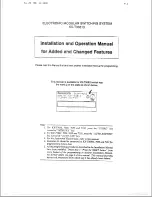
nuggetf
code39
Before You Begin
xxi
Conventions for Input From a Keypad or Keyboard
This table describes the formatting conventions for input from PC or host computer
keyboards and terminal keypads:
Convention
How to Interpret the Convention
Special text
Shows the command as you should enter it into the terminal. See
“Conventions for Commands” later in this chapter.
Italic text
Indicates that you must replace the parameter with a value. See
“Conventions for Commands” later in this chapter.
Bold text
Indicates the keys you must press on a PC or host computer keyboard.
For example, “press Enter” means you press the key labeled “Enter” on
the PC or host computer keyboard.
Shows the key you must press on the terminal. For example, “press
” directs you to press the Enter key on the terminal keypad.
T 3 ,
Shows a series of terminal keys you must press and release in the order
shown. For example, “Press
T 3 , to run the TRAKKER
Antares 2400 Menu System.”
– – L
Shows a series of terminal keys you must press simultaneously. Also,
you must press and hold the keys in the order shown. For example,
“Press
– – L to reset the terminal.”
Conventions for Bar Codes
You can scan the bar codes listed in this manual to enter data or perform a command.
The bar code labels in this manual are printed in the Code 39 symbology. Each bar code
includes the name and human-readable interpretation. For example:
*$+*
Change Configuration
*$+*
Name
Bar code (Code 39)
Human-readable
interpretation
242XU.146
The asterisks (*) at the beginning and end of the human-readable interpretation are the
start and stop codes for a Code 39 bar code label. If you are using a bar code printing
utility, it may automatically supply the asterisks as the start and stop code, so that you
only need to type the actual text of the command. You can also create and print
configuration labels and reader command labels in Code 93, which has its own start and
stop codes.
Summary of Contents for Trakker Antares 2420
Page 1: ...TRAKKERAntares 2420and2425 Hand HeldTerminal P N 064024 006 User s Manual...
Page 15: ...nuggetf code39 Contents xv Glossary Index G I...
Page 16: ...xvi...
Page 24: ...xxiv...
Page 25: ...nuggetf code39 Getting Started 1...
Page 26: ...1 2...
Page 60: ...1 36...
Page 61: ...Learning How to Use the Terminal 2...
Page 62: ...2 2...
Page 103: ...Co de 39 Nugget Configuring the Terminal 3...
Page 104: ...Co de 39 Nugget 3 2...
Page 134: ...3 32...
Page 135: ...Operating the Terminal in a Network 4...
Page 136: ...4 2...
Page 173: ...Using Custom Applications 5...
Page 174: ...5 2...
Page 193: ...Troubleshooting 6...
Page 194: ...6 2...
Page 219: ...Running Diagnostics 7...
Page 220: ...7 2...
Page 243: ...Reader Command Reference 8...
Page 244: ...8 2...
Page 268: ...8 26...
Page 269: ...Configuration Command Reference 9...
Page 270: ...9 2...
Page 389: ...Terminal Specifications A...
Page 390: ...A 2...
Page 404: ...A 16...
Page 405: ...Full ASCII Charts B...
Page 406: ...B 2...
Page 415: ...International Character Support C...
Page 416: ...C 2...
Page 427: ...Using the Default Applications D...
Page 428: ...D 2...
Page 438: ...D 12...
Page 439: ...Glossary G...
Page 440: ...G 2...
Page 463: ...Index I...
Page 464: ...I 2...
Page 480: ...I 18...
















































